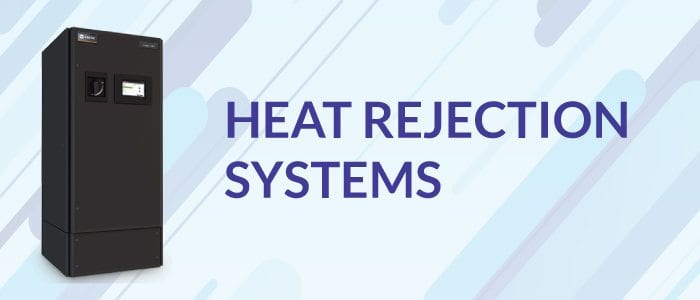3 Essential Heat Rejection Systems for Your IT Space
In spaces where essential data is stored, maintaining a cool, dry environment for efficient operation can be a challenge.
IT professionals must explore methods to maximize their space while monitoring these areas to minimize downtime risks, improve energy efficiency, and cut operational costs.
As these spaces continue to increase in density and criticality, computer room air conditioning units (CRAC) must be highly responsive and scalable.
Consider these heat removal methods:
Air Cooled System
For small to medium sized IT applications with standard availability requirements, there are two types of air cooled CRAC systems. These systems are easy to maintain and have a low overall cost.
Air Cooled DX System / Split System
In the air-cooled DX system, there are two essential components; a computer room air conditioner (CRAC) and a condenser. Half the components of the refrigeration cycle are in the CRAC unit and the rest are outdoors in the air-cooled condenser, which is why it’s often referred to as a Split System.
Refrigerant circulates between the indoor and outdoor components in pipes, and the heat is pumped to the outdoor environment.
Air Cooled Self-Contained System
In a one-piece, self-contained air-cooled system, the refrigeration cycle is located within a single enclosure in the IT environment.
Heat exits the self-contained system in the form of exhaust air. This hot stream of air is routed away from the IT room to the outdoors to ensure proper cooling of computer room equipment.
Liebert SRC Mini-Split Cooling System
The Liebert® SRC™ system is a high efficiency, simple and easy to install mini-split air conditioning system for server room cooling, network closets and other edge computing IT spaces.
- Capacity: 5.3-10.5 kW
- Heat Rejection Type: Air, Split System
- Form Factor: Wall-mount
- Humidity Control: No
Glycol/Water Cooled System
Gylcol Cooled System
Gylcol cooled CRAC units are joined with a dry cooler, and its refrigeration cycle is contained in a one-piece enclosure. Glycol cooled systems are typically found in infrastructures that have moderate to high availability requirements. This type of heat removal system uses a heat exchanger instead of a condensed coil.
The heat exchanger uses glycol, a combination of water and ethylene glycol, to collect heat from the conditioner and move it away from the IT environment.
The glycol transports the mixture outside through a system of pipes to a fluid cooler.
As heat moves to the outside, fans push outdoor air through the coil into the fluid cooler. Additionally, a pump assists the flow of the glycol to and from the computer room air conditioner and fluid cooler.
Glycol pipes are capable of running longer distances than an air-cooled system while performing with only one dry cooler and pump for multiple CRAC units.
Water Cooled System
Water Cooled Systems are typically found in data centers that have moderate to high availability requirements.
Instead of using air cooling for heat removal, this type of system uses water as its heat conductor. A water-cooled CRAC unit is joined with a cooling tower, rather than a dryer cooler. The refrigeration cycle parts are located directly in the CRAC unit.
A water condenser collects and carries heat away from the IT space and rejects it to the outside through the cooling tower.
The cooling tower will reject heat from the IT room to the outdoor environment by applying warm condenser water onto top of the tower, allowing it to evaporate as it flows to the bottom. Additionally, a fan helps speed up this evaporation process.
Liebert PDX Compact Cooling System
The Liebert PDX direct expansion cooling system offers the industry’s highest efficiency, protection and capacity per footprint for server room cooling, network closets, and other small spaces.
- Capacity: 11-28kW
- Heat Rejection Type: Flexible, Self-Contained
- Form Factor: Floor-mount
- Humidity Control: Yes
Chilled Water System
In data environments with moderate-to-high availability requirements, water-cooled chilled systems are a cost-effective way to cool entire infrastructure.
In this heat removal system, a computer room air handler (CRAH) is combined with a chiller. The refrigeration cycle circulates from the computer room air conditioning system to a water chiller. From there, the chilled water pumps to a the CRAH located inside the IT room.
Heat is removed from the IT environment through the chilled water flowing out the CRAH and returning to the chiller.
At the chiller, heat removed from the returning chilled water is moved back to a water condenser that transports it outside the environment.
Liebert CRV In Row Cooling System
The Liebert CRV is a multi-option, precision data center cooling solution providing temperature and humidity control. It integrates within a row of data center racks, providing cooling close to the server heat source, for efficient and effective data center heat management.
- Capacity: 19.6-40kW
- Heat Rejection Type: Flexible, Self-Contained
- Form Factor: In-Row
- Humidity Control: Yes
Your IT Infrastructure Partner
Maintaining ideal temperatures in your IT infrastructure is essential for mitigating the risks of downtime. Therefore, selecting the best cooling system is necessary to ensure equipment doesn’t overheat and shut down.
For more insights on cooling small IT spaces, check out Vertiv’s infographic.
As your local Vertiv business partner, we provide solutions that can help you meet capacity demands and lower operating costs.
Our computer room air conditioning solutions provide peace of mind, increased energy efficiency and availability, while remaining flexible enough to adapt to various IT environments.
For more information, contact us today.

